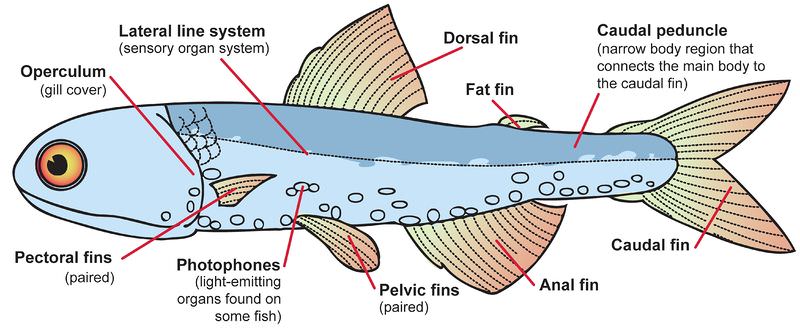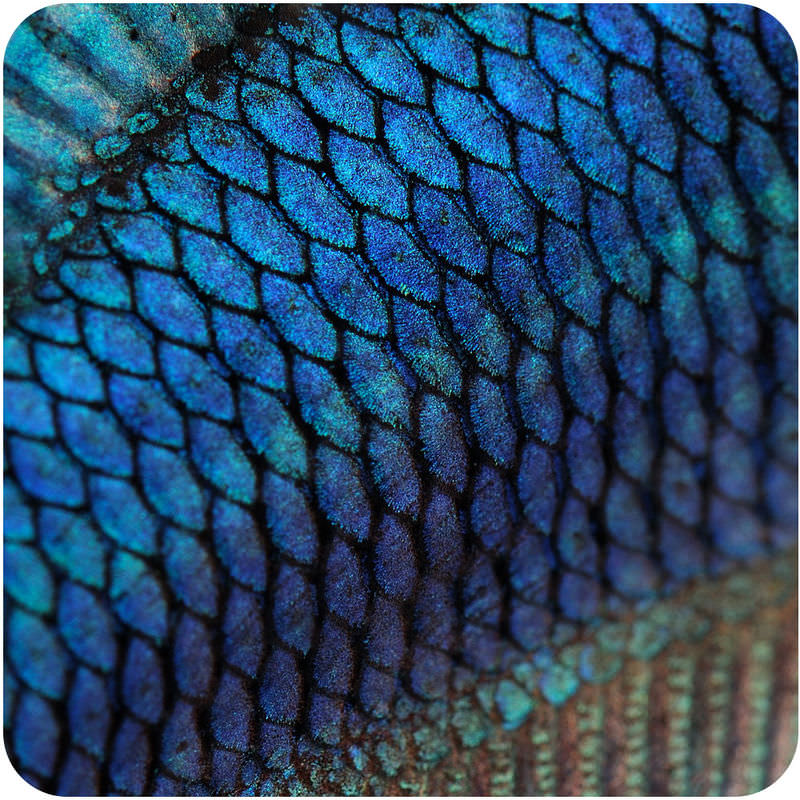12.30: Fish
- Page ID
- 1414

What are these geometric shapes?
These are the scales - the skin - of a blue Siamese fighting fish, and they almost look like a piece of art. They also look like they form a smooth, streamlined skin. Why is this important to a fish?
Structure and Function in Fish
Fish are aquatic vertebrates. They make up more than half of all vertebrate species. They are especially important in the study of vertebrate evolution because several important vertebrate traits evolved in fish. Fish show great diversity in body size. They range in length from about 8 millimeters (0.3 inches) to 16 meters (about 53 feet). Most are ectothermic and covered with scales. Scales protect fish from predators and parasites and reduce friction with the water. Multiple, overlapping scales provide a flexible covering that allows fish to move easily while swimming.
Adaptations for Water
Many structures in fish are adaptations for their aquatic lifestyle. Several are described below and shown in Figure below.
- Fish have gills that allow them to “breathe” oxygen in water. Water enters the mouth, passes over the gills, and exits the body through a special opening. Gills absorb oxygen from the water as it passes over them.
- Fish have a stream-lined body. They are typically long and narrow, which reduces water resistance when they swim.
- Most fish have several fins for swimming. They use some of their fins to propel themselves through the water and others to steer the body as they swim.
- Fish have a system of muscles for movement. Muscle contractions ripple through the body in waves from head to tail. The contractions whip the tail fin against the water to propel the fish through the water.
- Most fish have a swim bladder. This is a balloon-like internal organ that contains gas. By changing the amount of gas in the bladder, a fish can move up or down through the water column.
 General Fish Body Plan. A fish has a stream-lined body with gills and fins.
General Fish Body Plan. A fish has a stream-lined body with gills and fins.Fish Organ Systems
Fish have a circulatory system with a two-chambered heart. Their digestive system is complete and includes several organs and glands. Jawed fish use their jaws and teeth to grind up food before passing it to the rest of the digestive tract. This allows them to consume larger prey.
Fish also have a centralized nervous system with a brain. Fish brains are small compared with the brains of other vertebrates, but they are large and complex compared with the brains of invertebrates. Fish also have highly developed sense organs that allow them to see, hear, feel, smell, and taste. Sharks and some other fish can even sense the very low levels of electricity emitted by other animals. This helps them locate prey.
Science Friday: No Strain, No Gain: Filter Feeding Mantas
Effortlessly, manta rays glide through the ocean gulping down plankton and fish eggs by the mouthful. In this video by Science Friday, Dr. Misty Paig-Tran reveals the multiple methods of filtration they use to sift a meal from the water.
Science Friday: Oarfish: The Ultimate Fish Tale
Thought to be the inspiration of "sea serpent" stories, the monstrously-long Oarfish provokes wonder in nearly all that witness it. In this video by Science Friday, Professor Misty Paig-Tran provides us with insights into this real-life "sea monster's" unusual physiology.
Summary
- Fish are aquatic, ectothermic vertebrates.
- Many structures in fish are adaptations for their aquatic lifestyle. For example, fish have a stream-lined body that reduces water resistance while swimming.
- Fish have gills for “breathing” oxygen in water and fins for propelling and steering their body through water.
Review
- What are gills? What purpose do they serve in fish?
- Describe the function of fish scales.
- Describe how fish use their muscles to swim.
- What is a swim bladder? How is it used?
| Image | Reference | Attributions |
 |
[Figure 1] | License: CC BY-NC |
 |
[Figure 2] | Credit: Zachary Wilson and Mariana Ruiz Villarreal (LadyofHats) Source: CK-12 Foundation License: CC BY-NC 3.0 |

